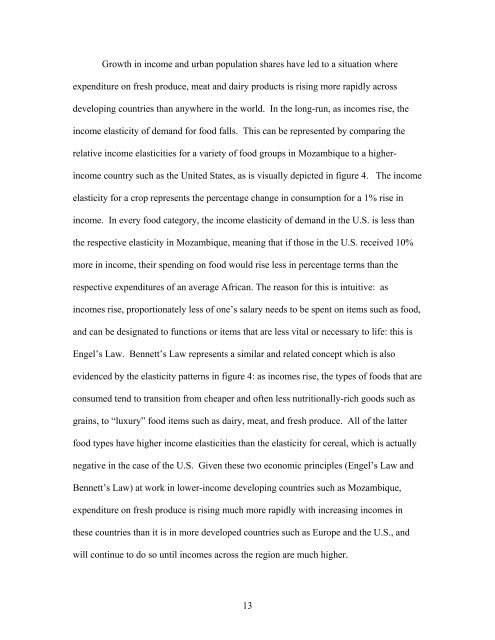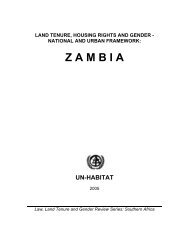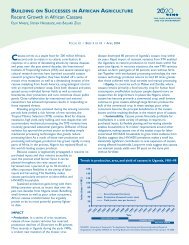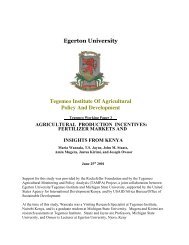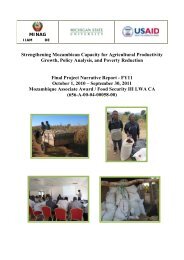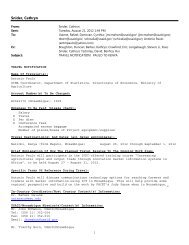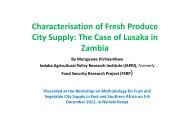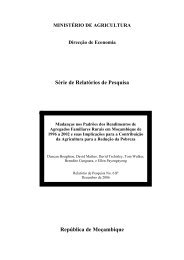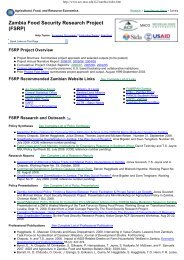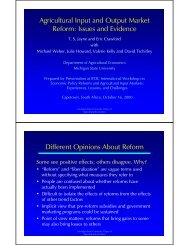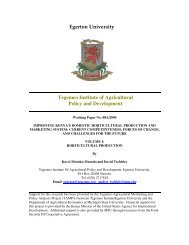Thesis Re-print: Does Selling Fruits or Vegetables - Department of ...
Thesis Re-print: Does Selling Fruits or Vegetables - Department of ...
Thesis Re-print: Does Selling Fruits or Vegetables - Department of ...
You also want an ePaper? Increase the reach of your titles
YUMPU automatically turns print PDFs into web optimized ePapers that Google loves.
Growth in income and urban population shares have led to a situation where<br />
expenditure on fresh produce, meat and dairy products is rising m<strong>or</strong>e rapidly across<br />
developing countries than anywhere in the w<strong>or</strong>ld. In the long-run, as incomes rise, the<br />
income elasticity <strong>of</strong> demand f<strong>or</strong> food falls. This can be represented by comparing the<br />
relative income elasticities f<strong>or</strong> a variety <strong>of</strong> food groups in Mozambique to a higher-<br />
income country such as the United States, as is visually depicted in figure 4. The income<br />
elasticity f<strong>or</strong> a crop represents the percentage change in consumption f<strong>or</strong> a 1% rise in<br />
income. In every food categ<strong>or</strong>y, the income elasticity <strong>of</strong> demand in the U.S. is less than<br />
the respective elasticity in Mozambique, meaning that if those in the U.S. received 10%<br />
m<strong>or</strong>e in income, their spending on food would rise less in percentage terms than the<br />
respective expenditures <strong>of</strong> an average African. The reason f<strong>or</strong> this is intuitive: as<br />
incomes rise, prop<strong>or</strong>tionately less <strong>of</strong> one’s salary needs to be spent on items such as food,<br />
and can be designated to functions <strong>or</strong> items that are less vital <strong>or</strong> necessary to life: this is<br />
Engel’s Law. Bennett’s Law represents a similar and related concept which is also<br />
evidenced by the elasticity patterns in figure 4: as incomes rise, the types <strong>of</strong> foods that are<br />
consumed tend to transition from cheaper and <strong>of</strong>ten less nutritionally-rich goods such as<br />
grains, to “luxury” food items such as dairy, meat, and fresh produce. All <strong>of</strong> the latter<br />
food types have higher income elasticities than the elasticity f<strong>or</strong> cereal, which is actually<br />
negative in the case <strong>of</strong> the U.S. Given these two economic principles (Engel’s Law and<br />
Bennett’s Law) at w<strong>or</strong>k in lower-income developing countries such as Mozambique,<br />
expenditure on fresh produce is rising much m<strong>or</strong>e rapidly with increasing incomes in<br />
these countries than it is in m<strong>or</strong>e developed countries such as Europe and the U.S., and<br />
will continue to do so until incomes across the region are much higher.<br />
13


